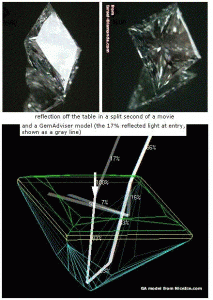When viewing a round brilliant diamond when would you expect to see the reflection of the entire table? I have read several articles/tutorials that state that on an ideal/excellet cut diamond the table will appear smaller than it actually is. Does the tableonly look smaller when viewed from the top looking down? If you twirl the diamond in the light would you expect to see a reflection of the full table at times? Should you never see a reflection of the entire table on an ideal/excellent cut diamond?
This question might seem trivial, but seeing as I don''t have a diamond infront of me I am unable to tell based on internet photos.
Cheers,
Detox
This question might seem trivial, but seeing as I don''t have a diamond infront of me I am unable to tell based on internet photos.
Cheers,
Detox







300x240.png)